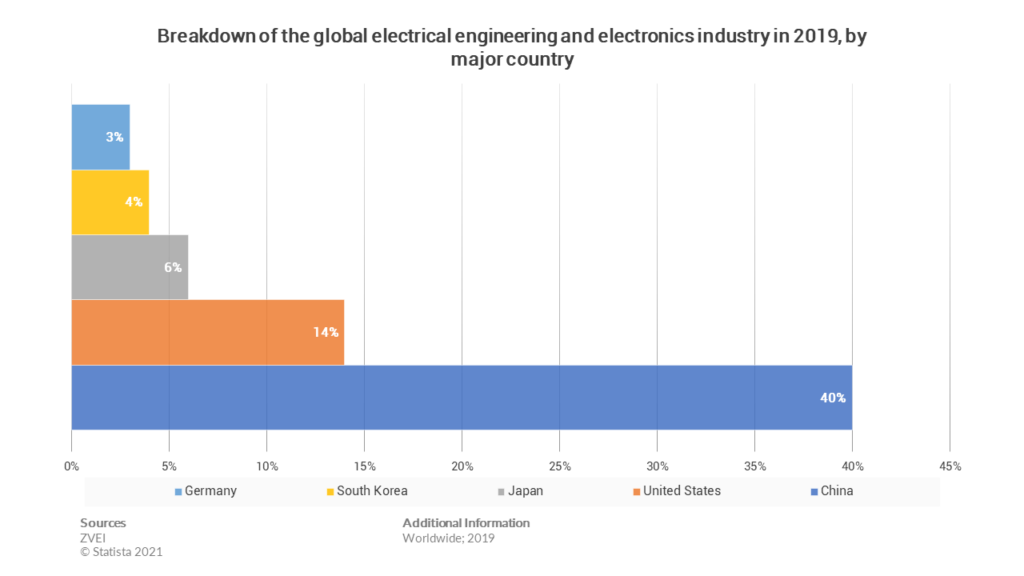The global electrical engineering and electronic equipment industry saw a significant breakdown after 2019, making it an area of concern for many countries. The industry is responsible for producing and installing complex systems across multiple sectors, and its lack of efficiency has directly impacted businesses worldwide. Everyone knows what happened in 2020 with the Corona virus, but the initial industry development is often overlooked. Covid affected the electronics industry in all countries.
The electronics industry is especially relevant for Germany, China, South Korea, the United States, and Japan. Such a major disruption to the industry could have profound implications for the global economy. This article will explore the percentage of this breakdown and its causes and analyze its effects on the industry. It will also outline what changes have been made since then to prevent such major disruptions in the future.
Percentage of Breakdown in Various Countries
The global electrical engineering and electronic industry have seen a significant growth in recent years, and China is responsible for 40 percent of it. The country’s economic growth over the past few decades has made it a significant player in the industry. However, its rapid expansion has led to several quality control issues resulting in many products recalls.
China accounted for 40% of the global market for electrical engineering and electronics. The Chinese electrical and electronics industry’s estimated value is around 1.8 trillion euros. Globally, the market for equipment and appliances is estimated to be about 4.5 trillion euros in 2019. It is estimated that the electrical equipment and appliances market will reduce by around three percent in 2020 compared with 2019. China’s government is putting a lot of focus on this strategic sector; however, its global dominance is shrinking.
The United States accounts for 14 percent of the breakdowns, Japan accounts for six percent, South Korea for four percent, and Germany for three percent. These countries are also major players in the industry but have stricter regulations that ensure product quality control. This highlights the importance of having proper rules and standards to prevent faulty products from entering the market.
It is essential to address these quality control issues as they pose a threat not only to consumers but also to the overall reputation of companies and industries involved.
Uncovering the Hidden Reason behind This Breakdown
The emergence of the pandemic in China had a significant effect on the supply chain of electronic products. Since China is a major player in the global electrical engineering and electronic industry, any breakdown in its production capabilities would ripple effect on the rest of the world. Unfortunately, that is precisely what happened when COVID-19 first started spreading.
The Chinese government took strict measures to contain the virus by implementing lockdowns and travel restrictions. This forced many factories to close down, causing disruptions in their supply chains. As a result, there needed to be more raw materials for electronic product manufacturing, such as semiconductors and LCD panels.
So many companies relying on China for their electronics production needs to be caused a domino effect throughout the industry. Companies were left scrambling to find alternative sources for parts or risk halting production altogether.

Recovery Strategies for Businesses in Electrical Engineering & Electronic Equipment Production
The global electrical engineering and electronic industry were undergone a major breakdown in 2019, with businesses struggling to maintain their momentum. However, by applying some factors from various studies, businesses can gain momentum quickly.
1. Achieving Momentum with User-Friendly Smart Devices
The global electrical engineering and electronic industry have recently faced a significant breakdown. However, businesses can recover from this setback by making user-friendly smart devices that cater to the needs of their customers.
In today’s digital age, consumers prefer products that are easy to use and provide value for money. By developing innovative technology into their devices, businesses can offer convenience and gain momentum in the market. These smart devices are designed with built-in sensors that collect data on usage patterns and adjust accordingly. This enhances user experience and improves product performance.
2. Recovery in Residential Market Increase in Demand
The residential sector has seen increased demand due to various factors such as population growth, urbanization, and changing lifestyle preferences. More people are moving into homes with modern amenities and technology, which requires advanced electrical engineering and electronic equipment. Businesses that cater to this market will benefit significantly by providing relevant products and services that meet customer needs.
Furthermore, this trend is broader than in developed countries and developing regions where rapid urbanization increases the need for housing infrastructure.
3. Provide Online Shopping Facilities for the Fastest Growth
With the convenience of online shopping, businesses can exhibit the fastest growth and regain their lost momentum. The trend towards online shopping has been accelerated by the COVID-19 pandemic, which has forced people to stay at home more often. As a result, customers are turning to e-commerce sites for their purchasing needs instead of visiting physical stores.
This shift in consumer behavior presents an opportunity for businesses to adapt and thrive despite setbacks due to the industry breakdown. Online facilities offer several benefits that traditional brick-and-mortar stores cannot match, such as 24/7 accessibility and a greater variety of products.
Wrapping Up
In conclusion, the global electrical engineering and electronic equipment industry breakdown of 2019 was a significant event that has impacted many countries worldwide. This article gave an overview of the leading causes behind the breakdown and solutions for recovery in 2020.




